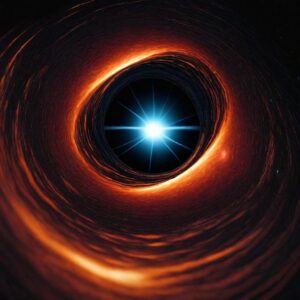A Black Hole is a Cosmic Enigma
The universe is a vast and mysterious place, filled with wonders that challenge our understanding of physics and reality. Among the most fascinating of these cosmic phenomena are black holes. These celestial objects captivate our imagination and stretch the boundaries
ies of our scientific knowledge. But what exactly is a black hole?
Defining a Black Hole
At its core, a black hole is a region of space where gravity is so strong that nothing, not even light, can escape its pull. This intense gravitational force is the result of an enormous amount of mass being compressed into a very small area. The boundary surrounding a black hole is known as the event horizon, beyond which nothing can return once crossed.
The Formation of Black Holes
Black holes form through a variety of processes, most commonly from the remnants of a massive star that has ended its life cycle. When such a star exhausts its nuclear fuel, it undergoes a supernova explosion. If the remaining core is sufficiently massive, it will collapse under its gravity, forming a black hole.
There are also supermassive black holes, which reside at the centers of galaxies, including our own Milky Way. These giants have masses ranging from millions to billions of times that of our Sun. The formation of supermassive black holes remains an area of active research, with theories suggesting they may grow through the merger of smaller black holes or the accretion of vast amounts of gas and stars over billions of years.
The Anatomy of a Black Hole
Understanding the structure of a black hole involves several key components:
- Singularity: At the very heart of a black hole lies the singularity, a point where matter is thought to be infinitely dense and the laws of physics as we know them cease to function. This is where the mass of the black hole is concentrated.
- Event Horizon: The event horizon is the “point of no return.” It marks the boundary beyond which nothing can escape the gravitational grip of the black hole. For an outside observer, this boundary appears as a dark sphere.
- Accretion Disk: Often, black holes are surrounded by an accretion disk of gas, dust, and other matter that spirals inwards, heating up and emitting radiation as it does so. This disk can be extremely bright and is often the source of the observable X-rays and gamma rays that indicate a black hole’s presence.
Black Holes and Spacetime
Albert Einstein’s theory of general relativity provides the framework for understanding black holes. According to this theory, massive objects warp the fabric of spacetime, creating what we perceive as gravity. A black hole represents an extreme example of this warping. The gravity around a black hole is so intense that it can significantly distort spacetime, bending light and time itself.
The Mysteries of Black Holes
Despite significant advances in our understanding, black holes remain shrouded in mystery. Questions abound about what happens to matter that crosses the event horizon, the nature of the singularity, and the possibility of black holes serving as gateways to other parts of the universe or even other dimensions.
One of the most intriguing concepts is Hawking radiation, proposed by physicist Stephen Hawking. According to this theory, black holes can emit radiation due to quantum effects near the event horizon, potentially leading to their gradual evaporation over time. This concept challenges the traditional view of black holes as eternal objects.
Observing Black Holes
Directly observing a black hole is impossible due to its nature. However, we can infer their presence and properties through their interactions with surrounding matter and their gravitational effects. In April 2019, the Event Horizon Telescope (EHT) collaboration released the first-ever image of a black hole’s event horizon, a supermassive black hole in the galaxy M87. This groundbreaking achievement provided visual evidence of black holes and further confirmed the predictions of general relativity.
Conclusion
A black hole is a cosmic enigma, a marvel of the universe that pushes the boundaries of our understanding of physics. From their formation to their mysterious inner workings, black holes continue to captivate scientists and the public alike. As our technology and theoretical frameworks advance, we may one day unlock even more secrets of these fascinating objects, bringing us closer to understanding the true nature of the universe.

